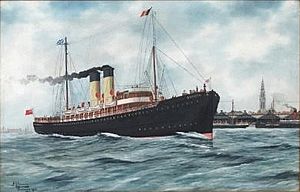SS Dresden (1896) facts for kids

Dresden in 1915, painting by A. J. Jansen
|
|
Quick facts for kids History |
|
|---|---|
| Name |
|
| Owner |
|
| Port of registry | |
| Route | Harwich - Hook of Holland (1897–1915) |
| Builder | Earle Company |
| Launched | 17 November 1896 |
| Fate | Sunk 21 January 1918 |
| General characteristics | |
| Tonnage | 1,830 GRT |
The SS Dresden was a British ship that carried passengers from 1897 to 1915. It became famous because a German inventor named Rudolf Diesel, who created the Diesel engine, disappeared from it in 1913. The Dresden was built in 1897 by the Earle Company in Hull. It sailed across the North Sea, connecting Harwich in England with the Hook of Holland in the Netherlands.
In 1915, the ship was taken over by the Royal Navy and renamed HMS Louvain. It was used during World War I until it was sunk in 1918.
The Mystery of Rudolf Diesel
On September 29, 1913, Rudolf Diesel boarded the Dresden in Antwerp, Belgium. He was on his way to a meeting in London. Diesel was a famous German engineer who invented the Diesel engine.
He went to his cabin around 10:00 PM. He asked to be woken up at 6:15 AM the next morning. However, he was never seen alive again. Later, a Dutch ship found a body floating in the sea. From the items and clothes found, it was identified as Rudolf Diesel.
In 1915, the British Navy took over the Dresden. They changed its name to HMS Louvain. The ship was then used as an armed boarding steamer during World War I. This meant it was a civilian ship equipped with weapons to help the navy.
Sinking of HMS Louvain
On January 21, 1918, a German submarine called SM UC-22 attacked the HMS Louvain. The submarine fired a torpedo at the ship in the Aegean Sea. The attack caused the ship to sink.
Sadly, seven officers and 217 men lost their lives. Only 16 people survived the sinking. Among those who died were 70 Maltese sailors. This made the sinking of the Louvain the biggest loss of life for Malta during the war. After this event, a special society was created to help the families of the Maltese victims.


